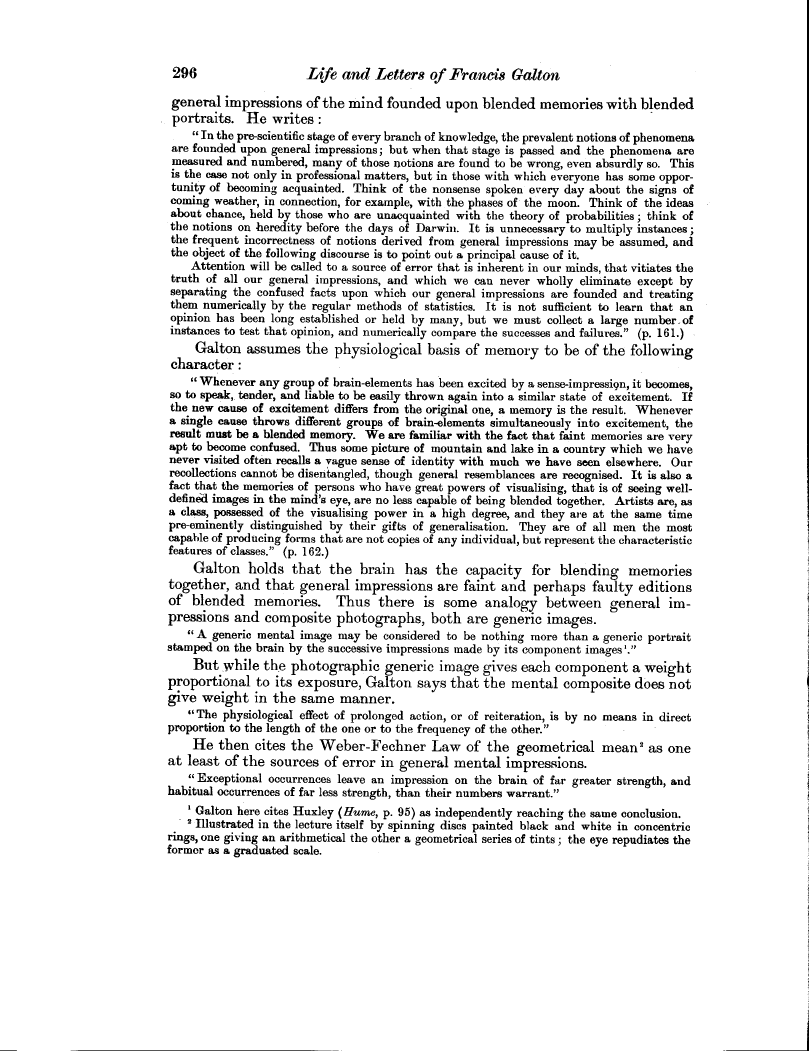296 Life and Letters of Francis Galton
general impressions of the mind founded upon blended memories with blended portraits. He writes
" In the pre-scientific stage of every branch of knowledge, the prevalent notions of phenomena are founded upon general impressions; but when that stage is passed and the phenomena are measured and numbered, many of those notions are found to be wrong, even absurdly so. This is the case not only in professional matters, but in those with which everyone has some opportunity of becoming acquainted. Think of the nonsense spoken every day about the signs of coming weather, in connection, for example, with the phases of the moon. Think of the ideas about chance, held by those who are unacquainted with the theory of probabilities ; think of the notions on heredity before the days of Darwin. It is unnecessary to multiply instances ; the frequent incorrectness of notions derived from general impressions may be assumed, and the object of the following discourse is to point out a principal cause of it.
Attention will be called to a source of error that is inherent in our minds, that vitiates the truth of all our general impressions, and which we can never wholly eliminate except by separating the confused facts upon which our general impressions are founded and treating them numerically by the regular methods of statistics. It is not sufficient to learn that an opinion has been long established or held by many, but we must collect a large number, of instances to test that opinion, and numerically compare the successes and failures." (p. 161.)
Galton assumes the physiological basis of memory to be of the following character
" Whenever any group of brain-elements has been excited by a sense-impressign, it becomes, so to speak,, tender, and liable to be easily thrown again into a similar state of excitement. If the new cause of excitement differs from the original one, a memory is the result. Whenever a single cause throws different groups of brain-elements simultaneously into excitement, the result must be a blended memory. We are familiar with the fact that faint memories are very apt to become confused. Thus some picture of mountain and lake in a country which we have never visited often recalls a vague sense of identity with much we have seen elsewhere. Our recollections cannot be disentangled, though general resemblances are recognised. It is also a fact that the memories of persons who have great powers of visualising, that is of seeing welldefined images in the mind's eye, are no less capable of being blended together. Artists are, as a class, possessed of the visualising power in a high degree, and they are at the same time pre-eminently distinguished by their gifts of generalisation. They are of all men the most capable of producing forms that are not copies of any individual, but represent the characteristic features of classes." (p. 162.)
Galton holds that the brain has the capacity for blending memories together, and that general impressions are faint and perhaps faulty editions of blended memories. Thus there is some analogy between general impressions and composite photographs, both are generic images.
"A generic mental image may be considered to be nothing more than a generic portrait stamped on the brain by the successive impressions made by its component images'."
But while the photographic generic image gives each component a weight proportional to its exposure, Galton says that the mental composite does not give weight in the same manner.
"The physiological effect of prolonged action, or of reiteration, is by no means in direct proportion to the length of the one or to the frequency of the other."
He then cites the Weber-Fechner Law of the geometrical mean' as one at least of the sources of error in general mental impressions.
" Exceptional occurrences leave an impression on the brain of far greater strength, and habitual occurrences of far less strength, than their numbers warrant."
' Galton here cites Huxley (Fume, p. 95) as independently reaching the same conclusion.
2 Illustrated in the lecture itself by spinning discs painted black and white in concentric rings, one giving an arithmetical the other a geometrical series of tints ; the eye repudiates the former as a graduated scale.

